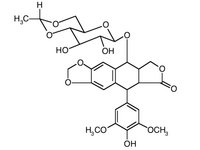Vepesid
Etoposide phosphate (Eposin®, Etopophos®, Vepesid®, VP-16®) is an inhibitor of the enzyme topoisomerase II. It is used as a form of chemotherapy for malignancies such as lung cancer, testicular cancer, lymphoma, non-lymphocytic leukemia, and glioblastoma multiforme. It is often given in combination with other drugs. more...
Chemically it derives from podophyllotoxin, a toxin found in the American Mayapple.
It is given intravenously or by mouth in capsule form. If the drug is given by IV it must be done slowly over a 30 to 60 minute period because it can lower blood pressure as it is being administered. Blood pressure is checked often during infusing. The physician may lengthen or shorten the time depending on circumstances.
Side Effects
Common are:
- low blood pressure
- hair loss
- pain and or burning at the IV site
- constipation or diarrhea
- metallic food taste
- Bone marrow suppression, leading to
- decreased white blood cell counts (leading to increased susceptibility to infections)
- low red blood cell counts (anemia)
- low platelet counts (leading to easy bruising and bleeding)
Less common are:
- nausea and vomiting
- allergic type reactions
- rash
- fever, often occurring shortly after IV administration and not due to infection
- mouth sores
Instruction
Patients are generally advised to call their doctor in case of fever, symptoms of infection or painful injection sites, as these may progress severely without adequate medical attention.
It is advised to drink lots of fluids after treatment to prevent damage to the bladder and kidneys, typically 1.5 to 3.5 litres of water on the day of treatment and for several days after.
Read more at Wikipedia.org



